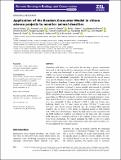Files in this item
Application of the Random Encounter Model in citizen science projects to monitor animal densities
Item metadata
| dc.contributor.author | Schaus, Jessica | |
| dc.contributor.author | Uzal, Antonio | |
| dc.contributor.author | Gentle, Louise K | |
| dc.contributor.author | Baker, Philip J | |
| dc.contributor.author | Bearman-Brown, Lucy | |
| dc.contributor.author | Bullion, Simone | |
| dc.contributor.author | Gazzard, Abigail | |
| dc.contributor.author | Lockwood, Hannah | |
| dc.contributor.author | North, Alexandra | |
| dc.contributor.author | Reader, Tom | |
| dc.contributor.author | Scott, Dawn M | |
| dc.contributor.author | Sutherland, Christopher S | |
| dc.contributor.author | Yarnell, Richard W | |
| dc.date.accessioned | 2021-06-03T16:30:02Z | |
| dc.date.available | 2021-06-03T16:30:02Z | |
| dc.date.issued | 2020-12 | |
| dc.identifier | 272468691 | |
| dc.identifier | fac0a3e4-8444-45f1-82c0-7abd9355ba08 | |
| dc.identifier | 85081986866 | |
| dc.identifier.citation | Schaus , J , Uzal , A , Gentle , L K , Baker , P J , Bearman-Brown , L , Bullion , S , Gazzard , A , Lockwood , H , North , A , Reader , T , Scott , D M , Sutherland , C S & Yarnell , R W 2020 , ' Application of the Random Encounter Model in citizen science projects to monitor animal densities ' , Remote Sensing in Ecology and Conservation , vol. 6 , no. 4 , pp. 514-528 . https://doi.org/10.1002/rse2.153 | en |
| dc.identifier.issn | 2056-3485 | |
| dc.identifier.other | Bibtex: schaus2020application | |
| dc.identifier.other | ORCID: /0000-0003-2073-1751/work/87404640 | |
| dc.identifier.uri | https://hdl.handle.net/10023/23308 | |
| dc.description | Funding: The People's Trust for Endangered Species, Nottingham Trent University, British Hedgehog Preservation Society, The Heritage Fund. | en |
| dc.description.abstract | Abundance and density are vital metrics for assessing a species’ conservation status and for developing effective management strategies. Remote-sensing cameras are being used increasingly as part of citizen science projects to monitor wildlife, but current methodologies to monitor densities pose challenges when animals are not individually recognizable. We investigated the use of camera traps and the Random Encounter Model (REM) for estimating the density of West European hedgehogs (Erinaceus europaeus) within a citizen science framework. We evaluated the use of a simplified version of the REM in terms of the parameters’ estimation (averaged vs. survey-specific) and assessed its potential application as part of a large-scale, long-term citizen science project. We compared averaged REM estimates to those obtained via spatial capture–recapture (SCR) using data from nocturnal spotlight surveys. There was a high degree of concordance in REM-derived density estimates from averaged parameters versus those derived from survey-specific parameters. Averaged REM density estimates were also comparable to those produced by SCR at eight out of nine sites; hedgehog density was 7.5 times higher in urban (32.3 km−2) versus rural (4.3 km2) sites. Power analyses indicated that the averaged REM approach would be able to detect a 25% change in hedgehog density in both habitats with >90% power. Furthermore, despite the high start-up costs associated with the REM method, it would be cost-effective in the long term. The averaged REM approach is a promising solution to the challenge of large-scale and long-term species monitoring. We suggest including the REM as part of a citizen science monitoring project, where participants collect data and researchers verify and implement the required analysis. | |
| dc.format.extent | 15 | |
| dc.format.extent | 516857 | |
| dc.language.iso | eng | |
| dc.relation.ispartof | Remote Sensing in Ecology and Conservation | en |
| dc.subject | Camera traps | en |
| dc.subject | Citizen science | en |
| dc.subject | Density estimation | en |
| dc.subject | Spatial capture-recapture | en |
| dc.subject | Spotlight surveys | en |
| dc.subject | Urban wildlife | en |
| dc.subject | GF Human ecology. Anthropogeography | en |
| dc.subject | QA Mathematics | en |
| dc.subject | QH301 Biology | en |
| dc.subject | DAS | en |
| dc.subject.lcc | GF | en |
| dc.subject.lcc | QA | en |
| dc.subject.lcc | QH301 | en |
| dc.title | Application of the Random Encounter Model in citizen science projects to monitor animal densities | en |
| dc.type | Journal article | en |
| dc.contributor.institution | University of St Andrews. Statistics | en |
| dc.contributor.institution | University of St Andrews. Centre for Research into Ecological & Environmental Modelling | en |
| dc.identifier.doi | 10.1002/rse2.153 | |
| dc.description.status | Peer reviewed | en |
This item appears in the following Collection(s)
Items in the St Andrews Research Repository are protected by copyright, with all rights reserved, unless otherwise indicated.

